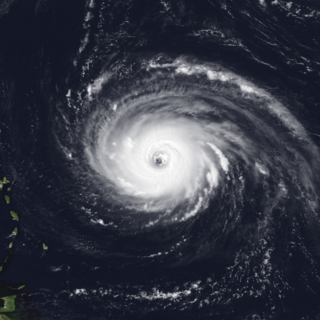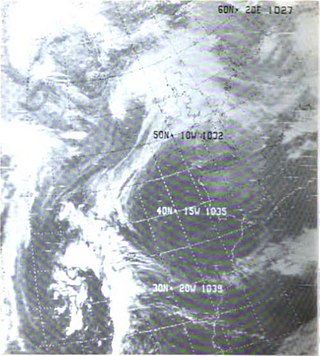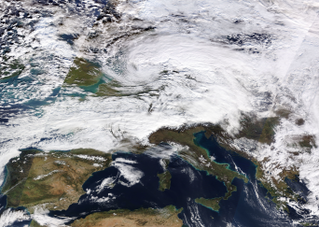
Tropical cyclone warnings and watches are alerts issued by national weather forecasting bodies to coastal areas threatened by the imminent approach of a tropical cyclone of tropical storm or hurricane intensity. They are notices to the local population and civil authorities to make appropriate preparation for the cyclone, including evacuation of vulnerable areas where necessary. It is important that interests throughout the area of an alert make preparations to protect life and property, and do not disregard it on the strength of the detailed forecast track.

Hurricane Luis was a long lived and powerful Category 4 hurricane. It was the strongest hurricane to make landfall and the third-most intense hurricane recorded during the 1995 Atlantic hurricane season. The storm, along with Humberto, Iris, and Karen, was one of four simultaneous tropical systems in the Atlantic basin.

Cyclone Kyrill was a low-pressure area that evolved into an unusually violent European windstorm, forming an extratropical cyclone with hurricane-strength winds. It formed over Newfoundland on 15 January 2007 and moved across the Atlantic Ocean reaching Ireland and Great Britain by the evening of 17 January. The storm then crossed the North Sea on 17 and 18 January, making landfall on the German and Dutch coasts on the afternoon of 18 January, before moving eastwards toward Poland and the Baltic Sea on the night from 18 to 19 January and further on to northern Russia.

Cyclone Andrea was an intense European windstorm that affected western and central Europe in early January 2012.

The Gale of January 1976, widely known as the "Capella" storm in Germany and the Ruisbroek flood in Belgium, was one in a series of extratropical cyclones and storm surges, which occurred over January 1976. The gale of 2–5 January 1976 resulted in severe wind damage across western and central Europe and coastal flooding around the southern North Sea coasts. At the time, this was the most severe storm of the century over the British Isles. Total fatalities reached 82 across Europe, although a figure of 100 is given by the World Meteorological Organization. Of these 24 were reported in Britain and 4 in Ireland. Overall losses of US$1.3 billion were incurred, with insured losses standing at US$500 million (1976).

The St. Jude storm, also known as Cyclone Christian, and other names, was a severe hurricane-force European windstorm that hit Northwestern Europe on 27 and 28 October 2013 causing at least 17 deaths. The highest windspeed was in Denmark, where a gust of 194.4 km/h (120.8 mph) was recorded in the south of the country on the afternoon of 28 October, the strongest wind recorded in the country's history.

Cyclone Niklas, also known as the Lentestorm in the Netherlands, was a European windstorm that affected areas of western and central Europe with widespread disruption to air, shipping and road transport at the end of March 2015.

Cyclone Tini a European windstorm that Western Europe, particularly Ireland and the United Kingdom on 12 February 2014. The storm brought hurricane-force winds to Ireland the with the Met Office and Met Éireann describing the storm as one of the most significant to affect Ireland, Wales and West England in recent decades. Tini was one of the strongest storms of the 2013–2014 Atlantic winter storms in Europe, and also brought heavy across the UK and Ireland exacerbating the 2013–2014 United Unitedwinter floods, and may have been the most damaging storm of the period.
The 2017–2018 European windstorm season was the third instance of seasonal European windstorm naming. France, Spain and Portugal took part in winter storm naming for the first time this season.

Sylke Tempel was a German author and journalist. At the time of her death, she had been the editor-in-chief of the foreign policy magazine Internationale Politik since 2008.

Cyclone Herwart was a European windstorm that affected Southern Denmark, Germany, Poland, Austria, Hungary and the Czech Republic on 28–29 October 2017. Named by the Free University of Berlin Meteorology Department, the storm was an extratropical cyclone formed as a secondary low to a more northerly centre of low pressure named Grischa coming southward from the Svalbard Islands region, the latter splitting in two low-pressure areas late on 28 October. The center of Herwart started rotating counterclockwise around the main low pressure area, passing over Norway, Sweden, Latvia and then losing power while moving over western Russia.

Storm David was a compact but deadly European windstorm that heavily affected the British Isles, France, Benelux, Central Europe, Northern Italy, Poland and parts of Eastern Europe in early 2018 with widespread hurricane-force gusts and severe snowfall, creating blizzard conditions in some areas. The storm caused extensive damage and traffic disruption. It was given the name David by Météo France while the FUB named it Friederike.
The 2018–2019 European windstorm season was the fourth instance of seasonal European windstorm naming in Europe. Most storms form between September and March. The first named storm, Ali, affected primarily the United Kingdom and Ireland on 19 September 2018.

The 2019–20 European windstorm season was the fifth instance of seasonal European windstorm naming in Europe. This is the first season in which the Netherlands participates, joining Ireland's and the United Kingdom's meteorological agencies. The new season's storm names were released on 6 September 2019. In July 2019, it was announced that storm seasons would run from 1 September 2019 to 1 September 2020. The Portuguese, Spanish and French meteorological agencies again collaborated too, joined by the Belgian meteorological agency.

Hurricane Lorenzo, also known as Storm Lorenzo for Ireland and the United Kingdom while extratropical, was the easternmost Category 5 Atlantic hurricane on record. Lorenzo was the twelfth named storm, fifth hurricane, third major hurricane and second Category 5 hurricane of the 2019 Atlantic hurricane season. The storm formed from a tropical wave that moved off the west coast of Africa on 22 September, growing larger in size over the course of its development. It strengthened into a hurricane on 25 September, and rapidly intensified into a Category 4 hurricane the following day before weakening due to an eyewall replacement cycle. After completing the cycle, Lorenzo rapidly restrengthened, peaking at Category 5 intensity on 29 September with 1-minute sustained winds of 160 mph. Steady weakening followed as the storm moved through unfavorable atmospheric conditions. Accelerating northeastward, Lorenzo skirted the western Azores on 2 October, and transitioned into an extratropical cyclone. The extratropical cyclone moved quickly towards Ireland and the United Kingdom and became the first named storm of the 2019–20 European windstorm season, before eventually dissipating on 7 October.

Storm Ciara was a powerful and long-lived extratropical cyclone that was the first of a pair of European windstorms to affect the United Kingdom and Ireland at peak intensity less than a week apart in early February 2020, followed by Storm Dennis a week later. Ciara caused widespread wind and flooding damage across Europe, and at least 13 fatalities.
The 2020–2021 European windstorm season was the sixth instance of seasonal European windstorm naming in Europe. This is the second season in which the Netherlands participates, joining Ireland's and the United Kingdom's meteorological agencies. The new season's storm names were released on 1 September 2020. Storms that occur up until 31 August 2021 will be included in this season. The Portuguese, Spanish, and French meteorological agencies will again collaborate too, joined by the Belgian meteorological agency.

Storm Malik was an extratropical cyclone that caused damage throughout northern Europe. It was named by the Danish Meteorological Institute in Denmark on 28 January 2022, and lasted until 30 January 2022. It caused 2958 severe wind reports and over 800,000 power outages in multiple countries. Seven people were killed in the storm, and a total of $415 million (USD) in damages were reported.

The 2022–23 European windstorm season was the eighth season of the European windstorm naming in Europe. The new season's storm names were announced on 1 September 2022. Storms that occur up until 31 August 2023 will be included in this season. This was the fourth season where the Netherlands participated, alongside the United Kingdom's Met Office and Ireland's Met Éireann in the western group. The Portuguese, Spanish, French and Belgian meteorological agencies collaborated for the sixth time, joined by Luxembourg's agency. This is the second season where Greece, Israel and Cyprus, and Italy, Slovenia, Croatia, Montenegro, North Macedonia and Malta named storms which affected their areas.


















